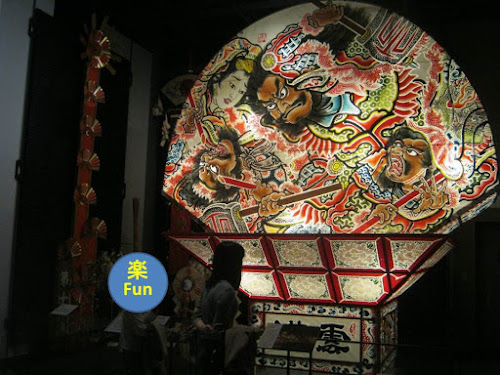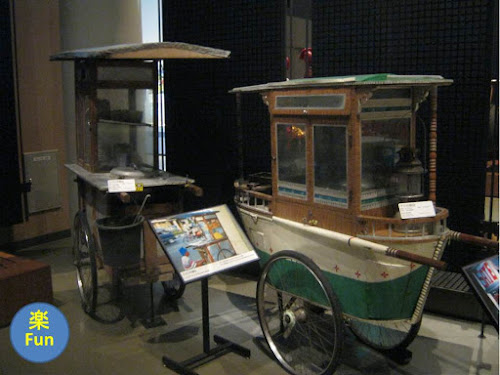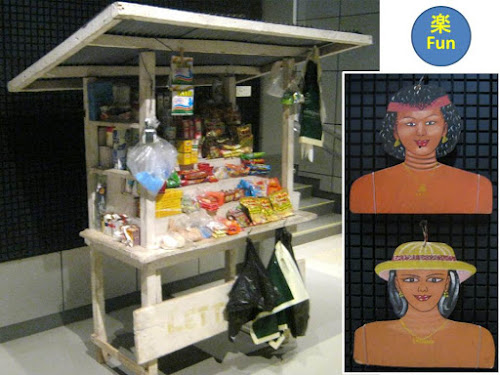This
is our national museum, so we can see many exhibits of Japan and other countries as well. Many
exhibits were collected after the WW2. This museum focused on the festival and
the livelihood, we can find lots of fun for the people.
2.
Everyday life(日々の暮らし)
3. Culture
of Okinawa 沖縄の文化
Appendix: Life
in the world 世界各地の暮らし
日本の民族学の研究頂点でもあり、世界の民族に関して展示している。展示品は戦後に収集したものだが、圧巻。さすが、国立博物館だ。丁度開館40周年であった。展示が祭りと日々の生業にフォーカスされており、人々の楽しみがたくさんあった。
At
the entrance, masks were displayed. It was written on the caption, “The mask
shows us the power which no one knows.” It was interesting to see the masks
from various countries. They were similar in that their expressions were
terrible.
世界の仮面の展示。「自分たちの知識が及ばない世界の力を形にしたもの」が仮面らしいが、並べてみると確かに面白い。
1. Festival
and “Hare” (祭りとハレ)
We Japanese distinguish everyday life and
unusual life clearly. Everyday life is called “Ke” and the unusual life is called “Hare”.
Festivals, annual events and wedding ceremonies belong to “Hare”, so we prepare
various things for “Hare”. The kimono (Japanese traditional outfit) for “Hare”
is called “Hare-gi” and “Gi” means clothes. Things for “Hare” were exhibited in
this room.
 |
| Neputa float of the summer festival in Hirosaki city、弘前のねぷた |
ハレ(晴れ)とケ(褻)という二つの場がある。ケは日常生活で、ハレは祭りや年中行事、結婚式などの非日常の儀式だ。日本人は、これを明確に区別していると思う。ハレについて、「人びとは、さまざまな道具を用いて日々の暮らしを営んでいるが、それとは趣の異なるモノが存在する。それは、祭りや年中行事などで用いられる趣向を凝らしたモノの一群である。こうしたハレのかたちには、人びとのハレの心性とその歴史があらわれている」とある。英訳不能。
1.1 Annual events (年中行事)
Annual
events are typical “Hare” events. It was written “Festivals and annual events
are held in each season. People pray for their happiness and safety. They
prepare things to invite gods and to hold festivals.” It was less fun in the old days, so it was important
to enjoy annual events, I think. Many
people used to go back to their parent houses for the annual events and have
family reunion parties. However, it is not so common nowadays. Many people stay
in the city during the annual event.
 |
| New Year’s decoration for the Toshigami god in Fukui、歳神の座(福井県) |
 |
| New Year’s decoration in Chichibu、埼玉県秩父市の正月飾り |
 |
| Bon’s decoration、盆飾り |
「ハレのこころ」として、「ハレのかたちには、季節の折々に祭りや年中行事を営み、幸福や暮らしの安泰を願ってきた人びとのこころが込められている。祭りや年中行事では、神霊を招いたり祭りの場を設けたりするためにさまざまな造形が用いられる」とある。楽しみが少ない時代は、これが大切だ。江戸時代は転居は制限されており、一族は近くに住んでいた。一族が集まる仕掛けが年中行事だったと思う。今は毎日がハレのようなもので、ご馳走も珍しくないし、それを目当てに盆正月に集まることもなくなってきた。
1.2
Rope and Pole(綱と竿)
A ritual
rope decoration shows us the sacred area. Many ropes were displayed. The
biggest one was a mask of a roadside god in Nagano. The photo on the right was the
ritual to prevent insect damage in Aichi. The straw figure was called “Sanemori-doll”.
「縄目や結び目に呪術的な威力をこめようとする考えは、しめ縄をはじめ、さまざまな縄と綱の造形を生んだ(訳せませんでした)。それを飾ることは聖域の証であり、競技や芸能の扮装にこれを用いているのも、超人的な力の表現であった」とある。様々なものがあるものだ。左写真の中央で目立つのは、長野市の道祖神の仮面。右は愛知県稲沢市の虫送りでの実盛人形。
It was written on the caption “Ritual poles stand in order to invite
gods from the sky. The top of the pole is designed in various shapes.”
竿かざりについて。「神霊を招きおろすために、天空たかく竿や柱をかかげる。その先端を飾る意匠には、降臨する神を迎えるかたちの諸類型がうかがえる。しだれた花、ひげのある籠、鯛や巾着といった縁起物は、いずれもそのなかの典型である」とある。
 |
| Festival of the rice field in Shima 三重県志摩市の伊雑宮(いざわのみや)御田植祭り |
The bamboo
pole was set in the field. People pray for the good crap.
志摩市の御田植祭りでは、太一と書かれた大きな竿が上げられている。豊作を願い、重労働の安らぎとなるお祭りだ。
1.3
Dolls and others(人形など)
 |
| Horse in the star festival、七夕のウマ |
This
straw horses are made on the 7th of July which is a day of the star
festival. Children draw the horses daytime, then they offer sweets and water to the horses. In the
evening, they float the horses on the river.
人形は「祭りや年中行事の際に神霊の顕現を具体的にあらわすために用いられ、特に疫病送りなど神霊を送り出すために用いる場合が多い」とある。七夕のウマ(千葉県成田市)は、七夕の日に子供たちが庭を引きまわして遊ぶ。七夕の笹竹に結び付けて、小麦饅頭や水を供え、夕方、川に流す。常総市地域交流センター・豊田城に展示されていたのと同類だが、丁寧に作られている。
 |
| Masks and costume、仮装 |
 |
| Back-carrying items、背負いもの |
 |
| Hand-held ritual items、とりもの |
2.
Everyday life(日々の暮らし)
The caption was written in English which stated “The majority of its land area is mountainous,
complexly punctuated by plains, basins, and gorges. The climates of its many
regions thus vary considerably throughout the year. Those differences have
given rise to a variety of lifestyles for the people of each locality have
adapted their environment.” I think it’s true. Actually the length of Japanese
archipelago is 3,500 km from northeast to south west. It is long and it consists of four main
islands and 6,000 small islands.
However I think the lifestyle of people has
been similar in many aspects. Annual events are almost common and our values
(living concisely, respecting gods, Mottainai policy and so on) are
similar.
日本は多様性が特徴とあるが、私は似ていると思う。海の暮らし、山の暮らし、町の暮らしの展示があり、沖縄とアイヌは別のコーナーとなる。
2.1 Life
in a town(町の暮らし)
The collection by Ms. Oomura who lived in Kyoto was exhibited in this section.
Many little things were displayed. I was surprised because she didn’t throw
away such little things.
 |
| Day trips、近場の物見遊山 |
These were postcards near Kyoto. She bought them in 1960's. She
visited a minor spot like Kasagi.
町のくらしでは、京都の大村しげコレクションが紹介されている。細々とした物をよく捨てずに取っておいたものだ。まずは、近場の物見遊山から。1960年頃のものだが、高野山、嵐山のような大観光地から、笠置山のようなマイナーなところまで、日帰りでも旅は楽しいものである。
 |
| Tourist destination、遠出 |
She also visited tourist destinations far from Kyoto, Unzen, Konpira,
Inuyama, Hakone, Kamakura, Tokyo, etc. She needed a long time to move because
there wasn’t a bullet train back then. She could have enjoyed a train travel. A tea pot,
which was sold at the station with a lunch box, was exhibited. A tea pot was
common as a bottle before a canned or PET bottle became common. I
guess she enjoyed the long journey with eating and chatting.
続いて、遠出。琴平、犬山、江の島、鎌倉、箱根、熊野、雲仙、東京などがある。新幹線のない当時は長い旅だったが、汽車土瓶、など汽車自体を楽しんでいたようにも思う。当然だが、三味線も展示されていた。
2.2
Life in the seaside area(海の暮らし)
People
pray for a good catch. During the festivals or catching many fishes,
fishermen show the special colorful flags on their ships, and their families look
forward to seeing it. On the other hand, they bring the god on the portable shrine to the sea. Are
they specific customs of Japan?
豊漁へのための祈り。大漁を知らせる派手な大漁旗、家族にも待ち遠しい。神輿を海に連れて行く。日本独特だろうか。
2.3 Life
in the mountainous area(山の暮らし)
The
photo below was taken in 1960 by T.Miyamoto who was a great folklorist.
Country roads were not developed well. It was the time when I was born.
荷を運ぶ牛は1960年に宮本常一が撮影したものだ。道が整備されていなかったのか、私が生まれたころだが大変なことだ。
Next
photos showed the life in Akiyama-go. There was a fireplace in the center of
the living room. Straw mats were set around the fireplace. There was a basket
to put a baby inside. Above the fireplace, there was a shelf to set food. Food
were dried and smoked there. A chimney is not common in Japanese houses.
山深い秋山郷の住まい。囲炉裏hに蓆が敷かれており、赤ちゃんを入れるかごもある。囲炉裏の上には、いぶしたり乾かしたりするようなものが置かれている。煙突はない。
* Living room in the various places (各地の居間)
Various
living rooms were exhibited in this museum. The room below was the traditional
Aynu house in Hokkaido, northern Japan. The roof and wall were made of thatch. Hokkaido is much colder than Tokyo. It seemed cold to live in this house. There was a fireplace too. Something was smoked above the
fireplace.
民博には世界各地の住まいが展示されており興味深い。下は、北海道平取町のアイヌの家屋。屋根や壁は茅ということで、ちょっと寒そう。囲炉裏があり、囲炉裏の上では何かを燻している。
The photo
below was the kitchen and living room in Vietnam. There was a fireplace near
the kitchen. It was very good that the baby basket was hung. It's comfortable
for a baby.
ベトナムのタイ系民族の囲炉裏まわりと台所。やはり、囲炉裏の上では何かを燻しているが、囲炉裏が部屋の中心ではなく台所だ。赤ちゃんを吊っているのが進んでいる。
3. Culture
of Okinawa 沖縄の文化
Okinawa prefecture is in the southeast of
Japan. Okinawa has particular culture. Their outfits were different from those
of the mainland. There was a Okinawa kimono on the left, and there was a coat on the
right. The gentleman is the former PM who wore Kariyushi shirt in Okinawa. It is
a nice shirt.
沖縄の文化:沖縄は独特の歴史であり、服も特徴がある。左が単衣で右が打掛。今は「かりゆし」が有名で、世界中で流行りそうな感じです。
Rites
of passage were introduced. The first rite was “Muuchii”. People hang mochi cakes
and eat.
沖縄の人生儀礼。まずは、生まれたとき。ムーチーという儀式で、お正月明けに魔よけの餅を吊るし、食べる。
This was the procession of a bride who was walking to a groom’s house
in 1960s. It was similar to the mainland.
1960年代だが、普通の日本の風景。
The rite below is called “Kajimayaa” which celebrates the 97th
birthday. It is said that it mimics the funeral. But it is very cheerful
festival and people spend a lot of money for it. It’s a good festival!
Kajimayaa in浜比嘉島: https://www.youtube.com/watch?v=StJDjyeSwlU
Kajimayaa (long version) : https://www.youtube.com/watch?v=9LsayOYzFaQ
カジマヤー、97歳を祝うお祭り。葬式を真似たともいうが、とにかく、明るく散財する、良い祭りだ。
The final
rite is a funeral. I saw this kind of procession in Nagano, but it was my sole
experience. It was a photo in 1952. The rite is a good reason to gather
people.
最後はお葬式の行列。長野で参加したが、それ以外では見たことがない。1952年の写真だ。とにかく集う。
Fun of the drinking alcohol was shown. Awamori (distilled alcohol)
is popular in Okinawa. The good Awamori makes a lot of bubble when it is
poured. I don’t know why. The guy on the left side made bubble. The equipment
on the right side was a distiller.
酒の楽しみ。沖縄には、泡盛(蒸留酒)がある。酒を入れると泡が立つのを良しとしたという。なぜ、泡が立つのか、私には分からない。左、泡を盛らす図、右、焼酎から蒸留する図。
Elaborate
tableware for Awamori. Good one makes Awamori delicious.
そして、酒器。酒器が良いと酒はうまい。凝っている様子が分かります。
The last
exhibition of Awanori was the painting of a wedding ceremony in the 18th
century (left side). People drunk, danced and drunk from a pot directly. Is it
common everywhere? Painting on the right side was a married couple in 1890's. I could
hear the conversation. “I drink!” “Stop drinking!” “Give me a little.” Is it
common either?”
泡盛シリーズの最後は、婚礼の酒宴の図(左、18世紀ごろ)、歌って踊って肩組んで、やかんから直接飲んで。いずこも同じか。そして、右は夫婦でのお酒の図(1890年代)。飲むぞ、もう止めなさい、声が聞こえてきそうだ。
Appendix: Life
in the world 世界各地の暮らし
(1) Korea
朝鮮半島
They had a party called “Chu-maku” (Alcohol curtain). They drunk makkolli
alcohol and ate gukbap (rice soup). Drinking party has made people happy.
酒幕というマッコリを飲みクッパを食べる会があった。酒宴はやっぱり楽しそうだ。
The photo below showed musical instrument and masks. Those were used
in the farming villages. It was written “The music and performance were
effective to keep the society stable. People were de-stressed by music.” “The
village band walked around fields and villages. The band consisted of a
conductor, players and dancers.” As far as I know, we don’t have such band in Japan. It must be nice.
農作業の間に行われたプンムル(農楽)やタルチュム(仮面劇)の面。「ときには、抑圧された非支配層の憂さ晴らしとして、社会の安定を保つ機能もはたしていた」とある。「農楽隊は、楽器の奏者、旗手、踊り手が隊列を組み、田畑やムラのなかを、演奏と踊りを交えながらねり歩く」とある。
The last
photo from Korea was the funeral. It was colorful and looked like a festival. Was
it a form of entertainment for the people? I’ll happy if Korean informs me.
野辺送りの写真だが、結構派手で、お祭りのようだ。これは楽しみなのか? 韓国方に教えて頂きたい。
(2) South East Asia 東南アジア
Those
were swords and cases of a cockfighting in Indonesia. Those things were properly arranged. The cockfighting was a rite and people offer chicken. It was also a form of gambling
at the same time. Men would be excited.
Stands
in various countries were exhibited. The place where stands opened was bustling and
exciting.
インドネシアの闘鶏用の剣とその収納箱。手の込んだ造りである。鶏を捧げる儀式と賭け事の両面があるとのこと。盛り上がる。
各地の屋台が展示されていた。屋台がある所は楽しい。
(3) Ghana
in Africa (ガーナ、アフリカ)
Kiosk and hangers. I loved these. We learn the life of the world at this museum.
ガーナのキオスクとハンガー。何か楽しい。ここでは世界各地の生活が分かる。
24 funs(楽Fun) were found. Visited in November, 2017


http://www.minpaku.ac.jp/english , accessed in August, 2020
Previous post (Museum in south Osaka with
many ancient relic) :
Next post (Glossary about rice farming
which is long lasting our livelihood) :

























Comments
Post a Comment